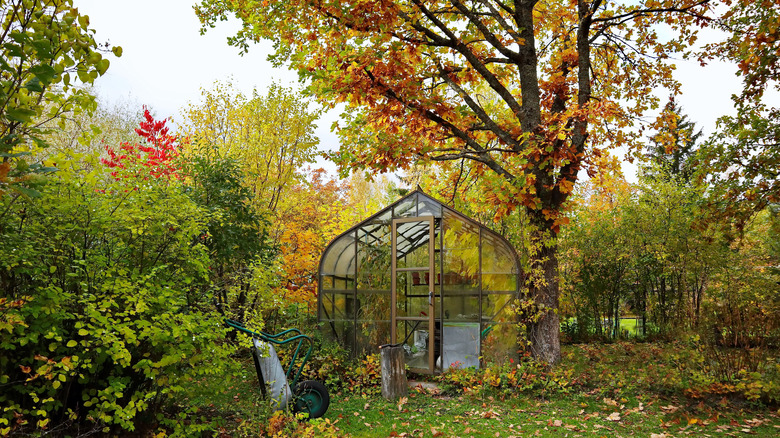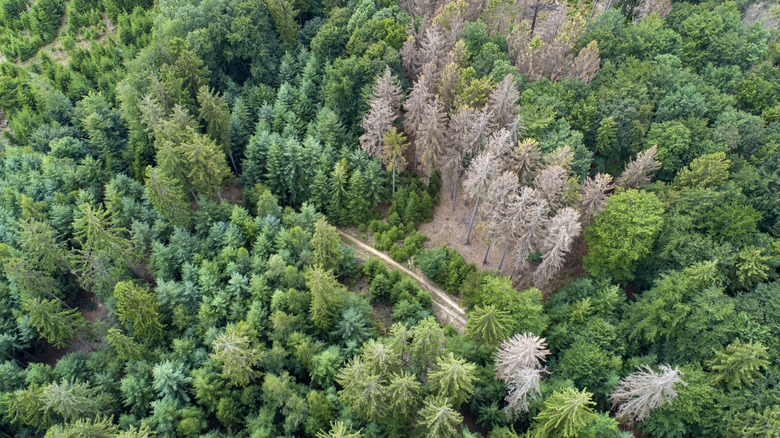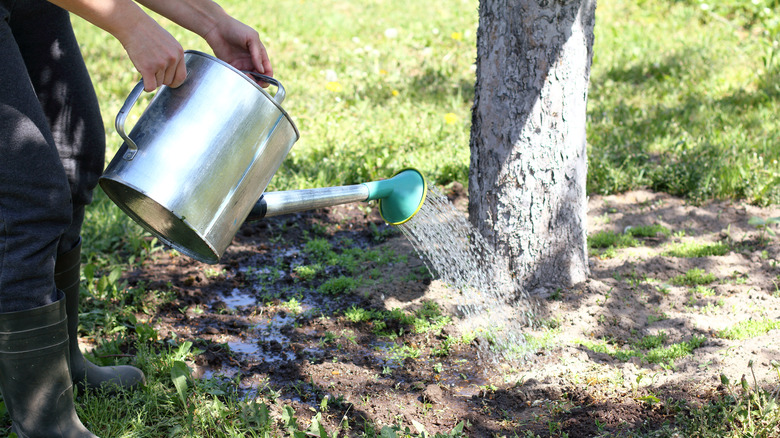What 'Early Fall' Really Means For The Leaves In Your Yard And Garden
Catch a falling leaf and stay safe from cold and illness all winter, so the superstition goes. But what happens if those leaves start to fall early? Does the passing on of good luck still hold true for the gardener and their garden alike? If the leaves on your deciduous trees — or, even worse, on your evergreens — are changing color and littering the ground in August rather than September, it could be a sign that they're stressed. They may need extra care to get them through the harsh winter months.
For climate scientists, fall officially starts on September 1. This is what's known as meteorological fall. We regular folk typically crave autumnal vibes a little later. The fall equinox heralds the moment the sun crosses the celestial equator; the daylight hours grow shorter, and the temperature drops. It also occurs in September, but the date shifts slightly from year to year. For trees, these climatic changes (combined with genetics) signal to stop devoting energy to growing and maintaining leaves. As the green-pigmented chlorophyll in the leaf disappears, other colors — like the red, orange, and yellow pigments of carotenoids and xanthophyll — come to the fore.
Causes of early fall
How early fall starts is related to geography: at what altitude and latitude you live, micro and macro weather patterns, and the local landscape. Another influence of an early change in leaf hue is the stress of summer droughts. Jim Gersbach from the Oregon Department of Forestry explains, "When you have a drought, dry conditions, trees aren't able to get water to all of their leaves," per KGW8. The result is early leaf discoloration from green to the familiar fall colors and leaf drop, in some cases, across swathes of forest.
A bout of frigid weather in July or August causes tree leaves to retain the nutrients (sugars) they produce through photosynthesis. According to Wendy Jones, Head Naturalist at Fernwood Botanical Garden, these sugars prompt the leaves to turn red or orange prematurely (via South Bend Tribute). Recent research suggests that early fall may be caused by an early spring. "On a year-to-year basis, an earlier/later spring was associated with an earlier/later autumn senescence," researchers found in a 2015 study published in Global Change Biology.
Other issues that stress trees on an individual or smaller scale — say, your backyard oak or Japanese maple — include disease and insect predation. A sick tree or one under attack dedicates all its energy to recovery, sacrificing its high-maintenance parts: its leaves. Deprived of nutrients and devoid of green chlorophyll, they're cut loose. Other small-scale stressors include too-hot soils, restricted root systems, and competition from plants that can grow under deciduous trees.
Keeping leaves on trees longer
If you've experienced early fall in the past and want to avoid it happening again, there are a few year-round best practices backyard gardeners should employ. First, make sure your trees are getting enough water. A once-a-week soaking right up until winter arrives is a good rule of thumb, but here's a trick to make sure. South Dakota State University professor of agriculture John Ball says to drive a screwdriver or other long, thin implement into the ground around your tree (via KELOLAND Local News and Weather). If it's damp to the touch when you pull it out, your trees are well-hydrated. Plan for the predicted longer, hotter summers by planting drought-hardy deciduous native trees like the Western Redbud, American Elm and its cultivars, and Kentucky Coffee Tree.
Other ideas to keep leaves on trees longer include pruning away deadwood in the spring following a period of stress (alongside regular winter pruning), keeping the area around your trees well mulched to reduce water evaporation and lower soil temperatures, and avoiding soil compaction — knowing when you need to aerate your lawn and garden beds is vital here. Fertilize your trees in early spring and summer when they grow new leaves. Unsure what denotes "early fall" in your area? Use The Foliage Report to familiarize yourself with fall patterns and track the change as the color moves across the U.S.


